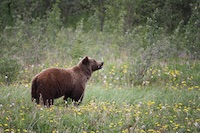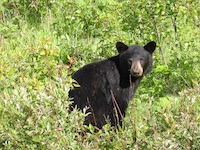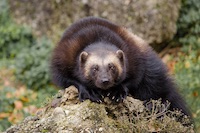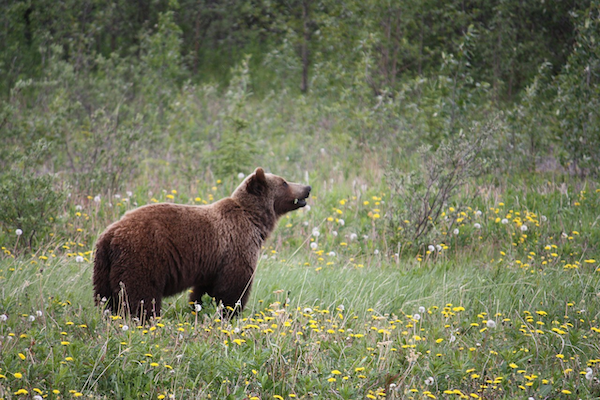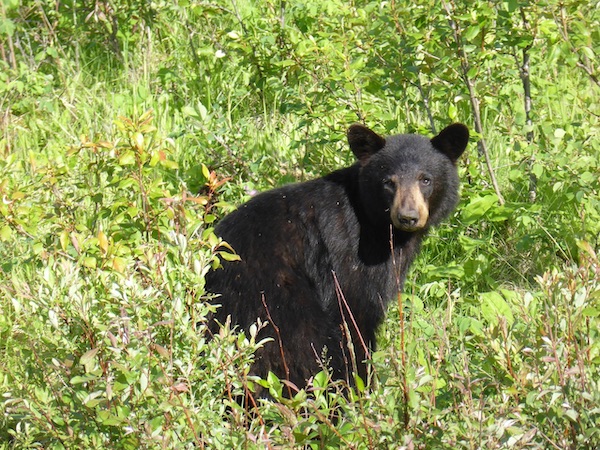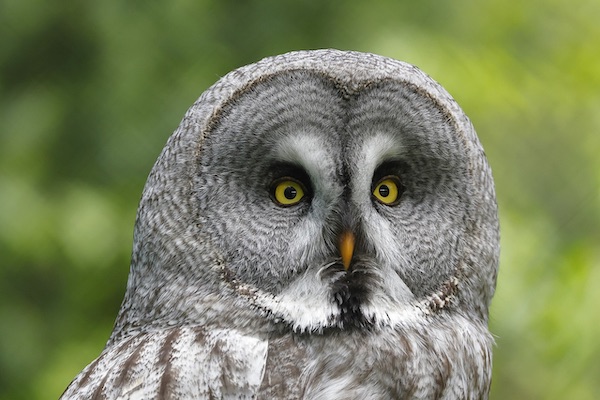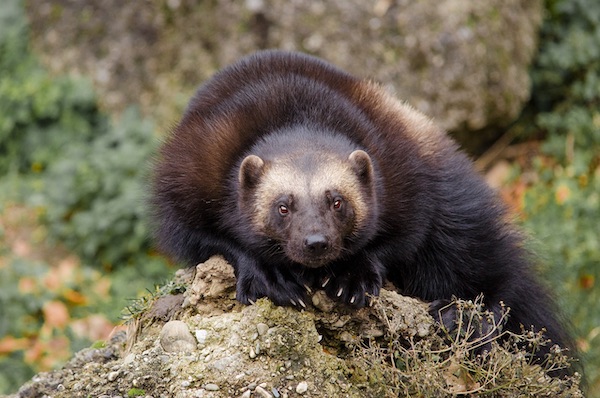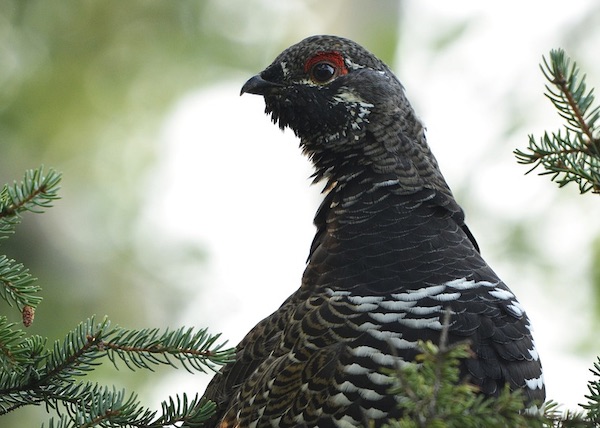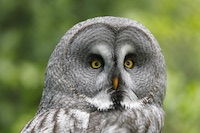
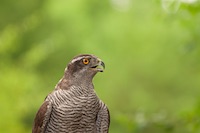
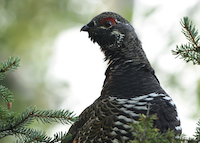
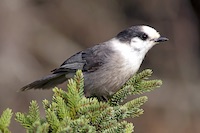
Great Gray Owl
Northern Goshawk
Spruce Grouse
Gray Jay
Grizzly Bear
Black Bear
Wolverine
Beaver
Grizzly Bear |
Photo Credit: https://pixabay.com/users/brigachtal-17257/ |
Grizzly bears, also known as brown bears, are among the largest meat-eating mammals. They can be found in North America in areas like Alaska, Canada, and the Rocky Mountains of Montana and Wyoming. An adult grizzly can grow to be 8 feet long and weigh about 900 pounds! Because of their size, grizzlies rarely climb trees, but they can reach speeds of 30 miles per hour for short distances.
Grizzly bears are opportunistic omnivores. They will search for and eat berries, plant roots, leaves, and fish and will hunt small animals, rodents, and even large animals such as the moose. Grizzly bears are solitary hunters that can pose threats to humans. They can be particularly dangerous if scared, surprised, or perceive a threat to their young. During the end of summer through fall, grizzlies eat an extra amount of food to build up fat in their bodies. They build up this fat for their bodies to use and to keep warm during hibernation.
Black Bear
Photo Credit: https://pixabay.com/users/keaton-171403/ |
Black bears are the most common bears in the world, and are one of only two bear species not classified as threatened or endangered. Despite their name, not all black bears are black in color. Their color can range from whitish to black as well as all shades of brown in between. Male black bears weight between 150-550 pounds, though much larger specimens have been found, including one male that weighed over 1,100 pounds in New Brunswick, Canada. Females are smaller and typically weigh around 200 pounds. Black bears are highly omnivorous in diet. While they will eat deer, elk, and moose, the bulk of their diet consists of roots, insects, larvae, grass, and other plants. Because of their versatile diet, they can be found in a variety of areas in North America from Alaska to Mexico. Black bears that live near humans must often be re-located because they become accustomed to feasting on trash and can cause serious damage to homes and cars. |
Great Gray Owl |
Photo Credit: https://pixabay.com/users/sharkolot-25467781/ |
Description
The Great Gray Owl is the largest owl found in North America . Measuring 28 inches in length, the "Gray Ghost" is actually mostly feathers and is lighter than many smaller owls. Adults weigh between 1/2 and four pounds. Females are heavier and larger than males. The Great Gray Owl is unmistakable, with a large head, conspicuous concentric rings around the face, small yellow eyes, large gray body, streaked gray underparts, small white bill, and long tail. It lacks ear tufts.
The Great Gray Owl does not build its own nest; rather, it takes over an old hawk or crow nest. Nesting occurs any time between March and May. The female typically lays four eggs, which are incubated from 4 to 5 weeks. Young owls fledge about three to four weeks after hatching and begin to fly one to two weeks later.
Diet
Small mammals such as mice, voles, and hares. It will occasionally take grouse and other small and medium-sized birds. The Great Gray Owl hunts at night and takes it prey upon silent wings. Like all owls, the Great Gray has specially adapted feathers that allow for silent flight. Owl victims cannot hear the flapping of wings. The Great Gray Owl has superb hearing and can detect movement beneath two feet of snow.
Range and Habitat
The Great Gray Owl breeds across the taiga belt in the Northern Hemisphere. In North America, the owl breeds from northern Canada and Alaska, south to the Great Lakes region and northern parts of the mountain west (such as Yellowstone National Park). In winter, some birds may be found farther south. Great Gray Owls prefer thick coniferous and mixed forests, especially near swamps or bogs.
Status
The Great Gray Owl is uncommon, though populations are thought to be stable. Clear-cutting of boreal forests has a negative impact on these birds.
Northern Goshawk
Description |
The Northern Goshawk has a blue-gray head, back, wings, and tail. Its throat, breast, and belly are white with blue-gray streaks. The most striking features of the goshawk, besides its robust appearance and power, are its blood red eyes. The Goshawk is the largest member of the Accipiter hawk family in North America (Females can measure 25 inches in length). Accipiters are long-tailed, short-winged hawks that often feed on birds. As is the case with all accipiters, the female goshawk is substantially larger than the male. Cooper's Hawk and the Sharp-Shinned Hawk are the other North American Accipiters. |
Diet |
| The Northern Goshawk is one of the most powerful predators to haunt the northern woods. A bird of deep forests, the goshawk ambushes its prey. Like a heat-seeking missile, the goshawk has the ability to fly between branches, through narrow passages, and around brush at frightening speeds. The Northern Goshawk's diet consists of small mammals, and small and medium sized birds. The Ruffed Grouse is often taken. |
Range and Habitat |
The Northern Goshawk is a rare hawk of northern boreal forests. In the Appalachian Mountains, the goshawk may be found in dense, deciduous woodlands. The Goshawk is found throughout the forested regions of Canada, the Rocky Mountain west, and northern sections of the Appalachian Mountains. It may also be found in Europe and Asia. |
Status |
| The Goshawk is rare and elusive. |
Wolverine |
Photo Credit: https://pixabay.com/users/wildfaces-932734/ |
The wolverine (Gulo gulo), often referred to as the "glutton" or "carcajou," is a remarkable and enigmatic creature that inhabits the remote and harsh landscapes of the Northern Hemisphere. Known for its tenacity, strength, and solitary nature, the wolverine has carved out a unique niche in ecosystems ranging from boreal forests to Arctic tundra.
Habitat and Range:Wolverines are primarily found in the northern regions of North America, Europe, and Asia. These robust mammals thrive in diverse habitats, including boreal forests, alpine tundra, and mountainous terrains. Their broad distribution is a testament to their adaptability in navigating a range of ecosystems, from dense taiga to the treeless expanses of the Arctic. Physical Characteristics:Wolverines are easily recognizable due to their stocky build, powerful limbs, and a distinctive, bushy tail. Their fur, which varies in color from dark brown to almost black, helps them blend into their surroundings. Wolverines also possess large, snowshoe-like feet, an adaptation that aids them in traversing deep snow and rugged landscapes with ease. Behavior and Diet:Despite their relatively small size compared to other carnivores, wolverines are known for their fearless and aggressive nature. Solitary creatures by preference, they have vast home ranges that they fiercely defend against other wolverines. Wolverines are opportunistic predators, feeding on a variety of prey including small mammals, birds, and carrion. Their powerful jaws and sharp teeth allow them to consume bones and frozen meat, giving them a unique advantage in scavenging and surviving in challenging environments. Reproduction and Family Life:Wolverines are solitary for much of the year, but during the breeding season, which typically occurs in late winter or early spring, they may form temporary pairs. The female wolverine constructs a den in a snow-covered crevice or beneath rocks to give birth to a litter of one to five kits. The kits are born blind and helpless, relying on their mother's care and protection. As they grow, the mother imparts essential survival skills to her offspring, preparing them for the harsh realities of the northern wilderness. Challenges and Conservation:Despite their formidable reputation, wolverines face various challenges in the modern world. Habitat loss, climate change, and human-wildlife conflict pose threats to their populations. Wolverines are particularly sensitive to changes in snow cover, as they rely on it for denning and accessing food. Conservation efforts are crucial to preserving their habitats and mitigating the impact of human activities on these resilient creatures. |
Gray Jay |
The Gray Jay, scientifically known as Perisoreus canadensis, is a fascinating bird species that inhabits the vast northern forests of North America. Renowned for its intelligence, bold behavior, and distinctive appearance, the Gray Jay has earned various nicknames, including the "Canada Jay" and "Whiskey Jack." Appearance:The Gray Jay is a medium-sized bird with a predominantly gray plumage, a lighter gray on the underparts, and a dark cap on its head. Its rounded wings and long tail contribute to its compact and agile physique. One of its most distinctive features is its white eyebrows, giving it a somewhat expressive and curious appearance. Habitat and Range:These intelligent birds are well-adapted to the cold climates of northern boreal and subarctic forests. Gray Jays can be found in Canada, Alaska, and parts of the northern United States. They thrive in coniferous forests, where they build their nests in the branches of spruce or fir trees, often choosing locations close to the tree trunk for protection. Behavior:Gray Jays are known for their bold and inquisitive behavior. Unlike many other bird species, they are not shy around humans and may even approach hikers and campers in search of food. They are opportunistic feeders, consuming a varied diet that includes insects, berries, small mammals, and even scavenging on leftovers or food from human hands. Social Structure:These birds exhibit strong social bonds and live in family groups. Gray Jays are also known for their caching behavior, storing food in tree crevices or under bark during the summer months to sustain them during harsh winter conditions. This caching behavior is crucial for their survival during the winter when food sources become scarce. Adaptations to Winter:Gray Jays are well-equipped to handle the challenges of the northern winter. Their thick plumage provides insulation against the cold, and they have a remarkable ability to survive harsh winter conditions. These birds are also known to breed earlier than many other bird species, ensuring that their young have a better chance of survival when resources are more abundant. Conservation Status:While the Gray Jay is not currently considered globally threatened, ongoing habitat loss and climate change pose potential risks to their populations. The conservation of their natural habitats is crucial to ensuring the continued well-being of these remarkable birds and the ecosystems they inhabit. Conclusion:The Gray Jay's captivating personality, adaptability, and unique characteristics make it a truly iconic resident of the northern forests. As we appreciate and learn more about these birds, it becomes evident that they play a vital role in maintaining the balance of the ecosystems they call home. Conservation efforts focused on preserving their habitats will not only benefit the Gray Jay but also contribute to the overall health and biodiversity of our northern forests. |
Spruce Grouse |
Photo credit: https://pixabay.com/users/lois0002-26057615/ |
The Spruce Grouse, also known as Falcipennis canadensis, is a fascinating bird species inhabiting the coniferous forests of North America. This ground-dwelling bird is well-adapted to the subarctic environments it calls home. Appearance:The Spruce Grouse exhibits distinct sexual dimorphism in its plumage. Males are characterized by dark plumage with bold white markings, while females have a more cryptic, mottled pattern that provides effective camouflage among the forest floor's vegetation. Both genders have a fan-shaped black tail with a broad, light-colored terminal band. An average spruce grouse measure about 16 inches in length and weighs a little more than one pound. Habitat and Range:Spruce Grouse are predominantly found in the boreal and subarctic forests of North America, including Canada and parts of the northern United States. Their preferred habitats include dense coniferous forests, especially those dominated by spruce and fir trees. The birds rely on these habitats for cover, nesting sites, and their primary food sources. Behavior and Diet:Being primarily ground-dwelling birds, Spruce Grouse are well adapted to life on the forest floor. They feed on a diet consisting mainly of conifer needles, buds, and fruits. During the winter months, when these food sources may become scarce, the Spruce Grouse may resort to consuming insects and other available vegetation. Unique Behaviors:Male Spruce Grouse engage in courtship displays to attract females during the breeding season. These displays often involve puffing up their chests, fanning their tails, and making soft hooting sounds. The females, in turn, select mates based on the males' displays of vigor and health. Adaptations to Cold Environments:Given their subarctic habitat, Spruce Grouse have evolved several adaptations to cope with harsh winter conditions. Their feathered legs provide insulation against the cold ground, and they are known to roost in snow to conserve body heat. Their cryptic plumage also aids in avoiding predators and enhances their ability to blend into the winter landscape. Conservation Status:While the Spruce Grouse population is currently stable, habitat loss due to logging and other human activities poses a potential threat. Conservation efforts focused on preserving the integrity of their preferred habitats are crucial for ensuring the continued well-being of this subarctic bird species. |
Beaver |
Photo Credit: https://pixabay.com/users/steveraubenstine-482057/ |
The beaver, known for its distinctive flat tail and gnawing abilities, is one of the largest rodents in North America. With a lifespan of up to 20 years in the wild, these semi-aquatic mammals are known for their engineering skills and their ability to transform the environment around them. Physical CharacteristicsBeavers have a distinctive appearance, with dense brown fur covering their large, stocky bodies. They have a broad, flat tail that they use for balance and communication, as well as powerful, chisel-like incisors that can cut through trees with ease. Beavers can grow to be up to four feet long and can weigh up to 70 pounds, making them some of the largest rodents in the world. Habitat and DistributionBeavers are native to North America, but they can also be found in Europe and Asia. They are typically found near bodies of water, such as rivers, lakes, and ponds, where they build their homes, called lodges or dams. These structures are made from sticks, mud, and rocks, and can be quite large, with some beaver dams measuring up to 2,700 feet in length. Ecological ImportanceBeavers play an important role in their ecosystem, as they are known for their engineering skills and their ability to transform the environment around them. By building dams and lodges, they create wetland habitats that support a wide variety of plant and animal life. These habitats also help to filter water, reducing sediment and pollutants and improving water quality. In addition to creating wetland habitats, beavers are also known for their ability to modify the landscape by cutting down trees and shrubs. While this behavior can sometimes be detrimental to human interests, such as flooding roads or damaging crops, it is an important part of the natural ecosystem. Beaver activity can create new habitats for other animals, such as birds and fish, and can also help to prevent erosion and promote the growth of new vegetation. Conservation StatusWhile beavers were once hunted extensively for their fur and meat, they are now protected in most areas of North America. In some cases, beavers have even been reintroduced to areas where they were once extinct, in order to help restore wetland habitats and promote ecological diversity. Despite their protected status, beavers still face threats from habitat destruction, pollution, and climate change. As such, it is important to continue to monitor beaver populations and take steps to protect their habitats and promote their conservation.
|
